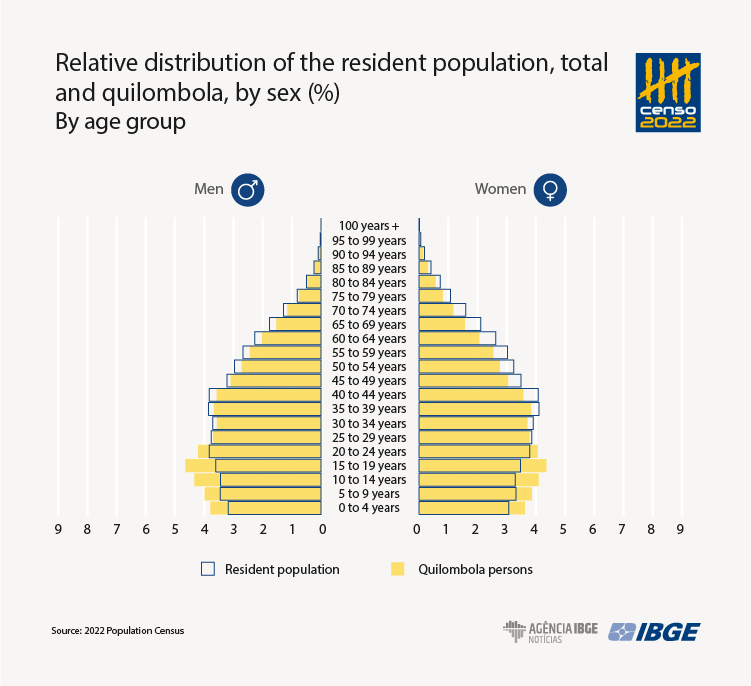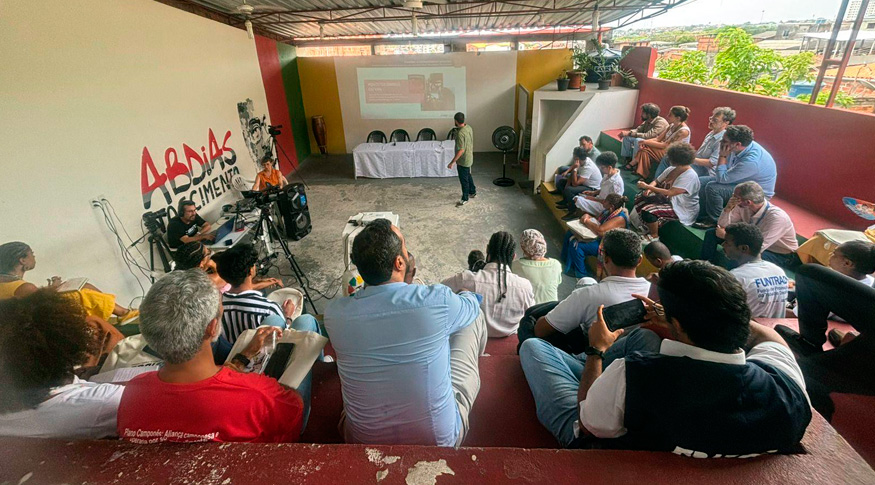2022 Census
2022 Census: Quilombola population is younger than entire Brazilian population
May 03, 2024 10h00 AM | Last Updated: May 07, 2024 11h58 AM
Highlights
- For the first time in the Brazilian history, the 2022 Census investigated the quilombola population and its demographic, geographic and socioeconomic characteristics, obtaining key information to deepen the knowledge and guide public policies.
- In 2022, the median age of the quilombola population was 31 years, below that of the total resident population in Brazil (35 years of age).
- The lowest median age of the quilombola population is in the North (26 years), followed by the Northeast (31 years). The latter concentrates 68.1% of the resident quilombola population.
- The percentage of the quilombola population aged up to 29 years in officially delimited territories is 5, whereas the elderly people aged 60 years and over participate with 11.9%.
- The sex ratio of the quilombola group was 100.08, which means 100 men for 100 women, whereas they were 94.2 men for each 100 women in the entire population.
- Slightly less than half (48.44%) of the quilombola population were aged up to 29 years, with the highest percentage in the group between 15 and 29 years of age (24.75%), followed by the group between zero and 14 years of age (23.69%) and the group aged between 30 and 44 years (21.92%).
- The percentage of elderly people (60 years and over) was 13.03%, below the rate of 15.81% of the entire resident population.

Of the 1.3 million quilombola persons in Brazil, nearly 24.7% were aged between 15 and 29 years, the age group that prevails in this population. For the effect of comparison, persons aged between 30 and 44 years prevailed in the total resident population in Brazil (23.5%). Still among the quilombola people, the second group with the highest weight was that aged between zero and 14 years (23.7%), followed by that between 30 and 44 years (21.9%). Altogether, nearly half (48.4%) of the quilombola population were aged up to 29 years in 2022. The median age of the quilombola population was 31 years, below the median age of the total resident population in Brazil (35 years of age).
In terms of sex, a minimum difference of 520 men was unveiled: 665.3 thousand men against 664.8 thousand women. Therefore, the sex ratio of the quilombola population was 100.08, i.e., 100 men existed for each 100 women in 2022. In the entire country, the ratio was 94.2 men for each 100 women.
This information is part of the release “2022 Population Census: Quilombola and Indigenous Populations, by sex and age, according to specific geographies - Population results,” which includes information related to the age structure and sex profile of the quilombola and indigenous populations, released today, May 3, at 10 AM, in an event held in the Campinho da Independência Quilombola Community, in Paraty (RJ) and broadcast by Digital IBGE. The complete survey can be accessed on the IBGE Portal and in platforms like SIDRA, Census Overview and Interactive Geographic Platform (PGI), the last two through interactive maps as well.
The results for the indigenous population can be accessed clicking on this link.

For the first time in the Brazilian history, the 2022 Census investigated the quilombola population and its demographic, geographic and socioeconomic characteristics, obtaining key information to deepen the knowledge and guide public policies. “This release unveils unprecedented data and information about the quilombola population, opening a series of possibilities in the field of Demography, Anthropology and even Geography. It is a very important publication for public policies of basic human rights, as it allows to know a reality then completely unknown about the quilombola population,” highlights Marta Antunes, the Census Coordinator of Traditional Communities and Peoples.
Antunes states that the younger age profile than the entire population was a hypothesis already existing among the researchers and the quilombola organizations, though the official information at national level did not exist.
People aged 60 years and over were 13.0% of the quilombola population, a lower percentage than this group of the total resident population in Brazil, which was 15.8%.
Quilombola population has an even younger age profile inside the territories officially delimited
Another important result concerns the age of the quilombola population when considered the location of the household inside the territories with some formal delimitation. “This geography allows to pinpoint an even higher weight of the younger age groups inside the quilombola territories officially delimited, as well as a reduction in the share of the elderly population living in these territories when compared to the entire set of the quilombola population aged 60 years and over,” explains Antunes. Altogether, the percentage of the quilombola population aged up to 29 years in the territories is 52.5%, whereas the elderly people aged 60 years and over participate with 11.8%.
“It is a very significant young population and growing, with spefici requirements in health, education and projects for the future of their territories. We are providing information that might guide managers, civil society and quilombola organizations in the development of public policies, as well as boost the demographic debate among the researchers,” complements Fernando Damasco, the IBGE´s Manager of Traditional Territories and Protected Areas.
It should be highlighted that only 12.6% of the quilombola population live in the quilombola territories officially delimited, whereas the others (87.4%) are out of these territories.

Concerning the quilombola population living outside quilombola territories officially delimited, the result is closer to the relative distribution of the entire quilombola population. “It is explained by the fact that the quilombola population out of the territories are most of the Brazilian quilombola population,” justifies the researcher.
Median age of quilombola population is 31 years; inside territories, it falls to 28 years
Another important indicator to assess the age characteristics of the population is the median age, the measure that uses age to divide the population into two equal parts. In other words, it is the age that separates the youngest half of the population from the oldest half.
In the quilombola population, the median age computed in the 2022 Census is 31 years, four years below the median age of the entire population living in Brazil, which was 35 years. Considering the quilombola persons living inside the quilombola territories officially delimited, the median age drops even more, to 28 years. On the other hand, the quilombola persons not living in these territories maintain the median age of 31 years.
Taking a look at the Major Regions, the lowest median age of the quilombola population is in the North (26 years), followed by the Northeast (31 years). The latter concentrates 68.1% of the resident quilombola population. The median age of the quilombola population living in quilombola territories is the lowest one in the North (24 years) and the highest one in the South (34 years).
Among the Federation Units, the lowest median ages of the quilombola population were in Amazonas (21 years), Amapá (25 years) and Pará (26 years). In contrast, the highest ones were in Rio Grande do Sul, Mato Grosso do Sul and Mato Grosso, all of them with 35 years of median age, followed by Minas Gerais, Espírito Santo and São Paulo, all of them with 34 years of age.
| Median age of the resident population, total and quilombola, by location in quilombola territories, according to the Major Regions and Federation Units - Brazil -2022 |
||||
|---|---|---|---|---|
| Major Regions and Federation Units | Resident population | |||
| Total | Quilombola persons | |||
| Total | Location in officially delimited Quilombola Territories | |||
| Inside officially delimited Quilombola Territories | Outside officially delimited Quilombola Territories | |||
| Brazil | 35 | 31 | 28 | 31 |
| North | 29 | 26 | 24 | 27 |
| Northeast | 33 | 31 | 29 | 31 |
| Southeast | 37 | 34 | 31 | 34 |
| South | 36 | 34 | 34 | 33 |
| Central-West | 33 | 33 | 30 | 34 |
| Source: 2022 Population Census. Note: Median age is the measure that uses the age criteria to divide the population into two equal parts, i.e., it is the age that separates the youngest half from the oldest half of the population. |
||||
Ageing index of quilombola persons is 54.98 against 80.03 of entire population
The results of the 2022 Census released today for the quilombola population also unveiled the ageing index, an indicator that relates two extreme age groups and can be built with different age ranges. In this case, the range used was the number of persons aged 60 years and over in relation to a group of 100 persons up to 14 years os age.
The entire Brazilian population has an ageing index of 80.03, i.e., there are 80 persons aged 60 years and over for each 100 persons up to 14 years of age. On the other hand, the quilombola population has an ageing index of 54.98. Therefore, there are 54 quilombola persons aged 60 years and over for each 100 quilombola persons aged up to 14 years.
Quilombola persons: predominance of men in age group up to 24 years
Another result of the release of the 2022 Census is the male predominance up to 24 years and female predominance from 30 years onwards, when sex and age group is analyzed. “The demographic studies indicate that the higher incidence of men in the first ages might be a consequence of a higher birth of male children in relation to female children.
In Brazil, in general, the contingent of men tends to decrease with the age due to the male excess of mortality, a phenomenon pinpointed in the Brazilian resident population - in this case from 19 years onwards - as related to deaths caused by external causes. In the case of the quilombola population, this decrease occurs later, from 24 years onwards,” details Marta Antunes. “However, different triggering criteria of the ethnic-quilombola belonging might influence these trends as well,” complements Marta Antunes.

The age pyramid of the quilombola population shows a larger base than that of the entire population up to the age group between 20 and 24 years. From the point of view of the age structure of the quilombola population, younger groups (up to 24 years of age) show a higher weight when compared with the entire population, with bigger differences in the age group between 15 and 19 years, in which the quilombola men have a proportion of 4.6% and men in this age group in the entire population, of 3.6%. On the other hand, quilombola women in this group have a proportion of 4.4% and women in this age group in the entire population, of 3.5%.
The smallest differences, among younger groups, are in the age group between 20 and 24 years, with 0.4 percentage points (pp) of difference between the proportion of quilombola men in the quilombola population and the proportion of men in this age group in the entire population, and quilombola women with 0.3 pp of difference. “The gradual narrowing of the groups under 14 years point out to an ageing process of the quilombola population and to a possible gradual drop in fertility,” states the researcher.
For Marta Antunes, the results of the 2022 Census for these ranges of sex and age somehow provide initial elements to understand the quilombola demographic dynamics, which points out to a mostly young population and growing: “The data show that these populations are growing, either due to a vegetative growth or to the recovery of previous population losses, which might raise specific needs for future generations,” argues the researcher. “These territories are alive, inhabited by populations that think their territories for future generations,” complements her.
The data provided in the geography of officially delimited quilombola territories, in turn, highlight how much these areas concentrate an even younger population. “The age structure shown in the officially delimited quilombola territories reinforces that these areas are not remnants of a distant past, yet they house a significant young population. Now we have an overview of this population by age range, including its geographic distribution, which provides elements to identify expected transformations in these territories over the next years,” concludes Fernando Damasco.
More about the survey
The “2022 Population Census: Quilombola and Indigenous People, by sex and age, according to specific geographies: Population results” brings information related to the age structure and sex profile of the quilombola and indigenous populations. The release is supported by the Ministry of Racial Equality.
The data will be available for Brazil, Major Regions, States, Municipalities, Legal Amazon, Legal Amazon by Federation Unit, officially delimited Quilombola Territory, officially delimited Quilombola Territory by Federation Unit, Indigenous Land and Indigenous Land by Federation Unit.
The first results of the 2022 Population Census for the quilombola population were released in July 2023 and be seen in the IBGE News Agency.




















